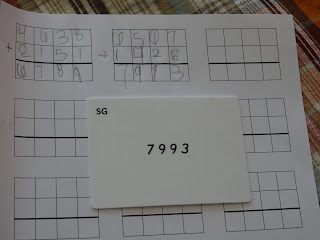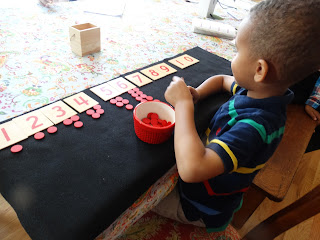STATIC ADDITION:
Here is a picture of the set of equations that we use for the stamp game. It breaks the equations up for the child depending on what they are working on. The answers are on the back which help create independence for the child.
The stamp game can be used for all four operations (addition, subtraction, multiplication, and division). This is the material, which again is color coded for the child. Hence, green is for units, blue for tens, red for hundreds, etc.
The stamp game also has specific paper to make it easier for the child, but you could easily make this yourself or use graph paper.
Here is what the equation card looks like. Again, these equations are fantastic because they are color coded for the child.
I have Nito write out his problem on the paper before he begins to set up his material on his felt mat.
Here is the problem laid out in the beginning. He first sets out the top number.
Then he lays out the second addend underneath. (If you click on the picture, the card with the number will be easier to see. I'm sorry if there is a glare.)
This picture shows that he starts with the units. So he pushed his 1 unit up with his 8 units since he is adding. Then he counted all of his units again to find that he had 9 units altogether.
Then he recorded his answer for the units.
Then he continued with the tens, and so on.
Recording his answer as he goes.
When he is done with the problem, he turns the equation card over to check his answer. Yay! He got it right. (The SG in the left hand corner indicates Stamp Game. We have additional equations for the Golden Bead Material (GBM) in the same box so it is helpful to have them labeled.)
DYNAMIC ADDITION:
Nito set up his problem in the same manner as if doing static addition. He laid out his first addend.
Then he laid out the second addend below.
He pushed his 6 units up with the 7 units. Then he starts to count them.
He stopped when he got to 10 and then replaced the 10 green unit squares with a blue 10 square shown above.
Now the blue 10 unit was put at the bottom of the tens column and the units column now has the remaining units, which is 3. He then recorded the 3 units on his paper.
He continued with pushing the tens together, counting, and recording his answer.
When finished, he checked his answer.

































